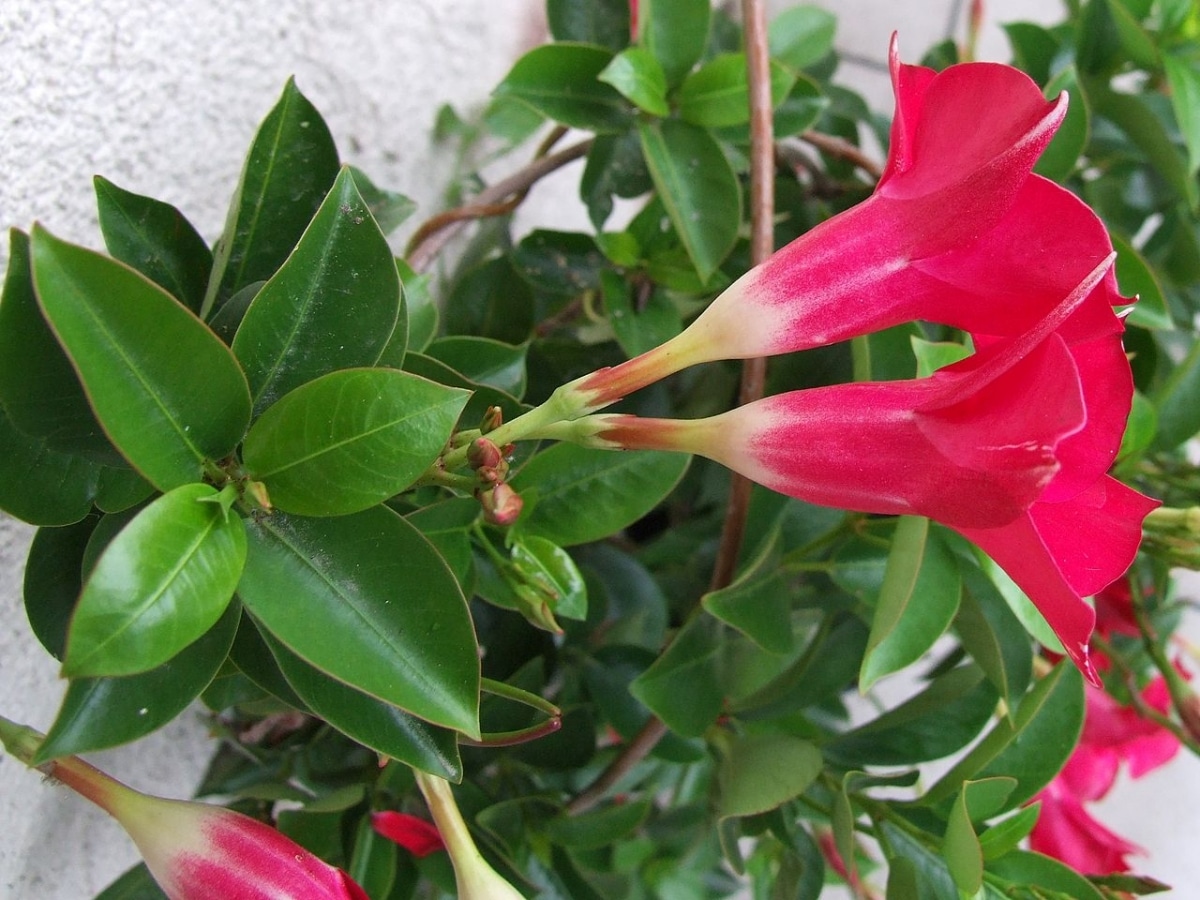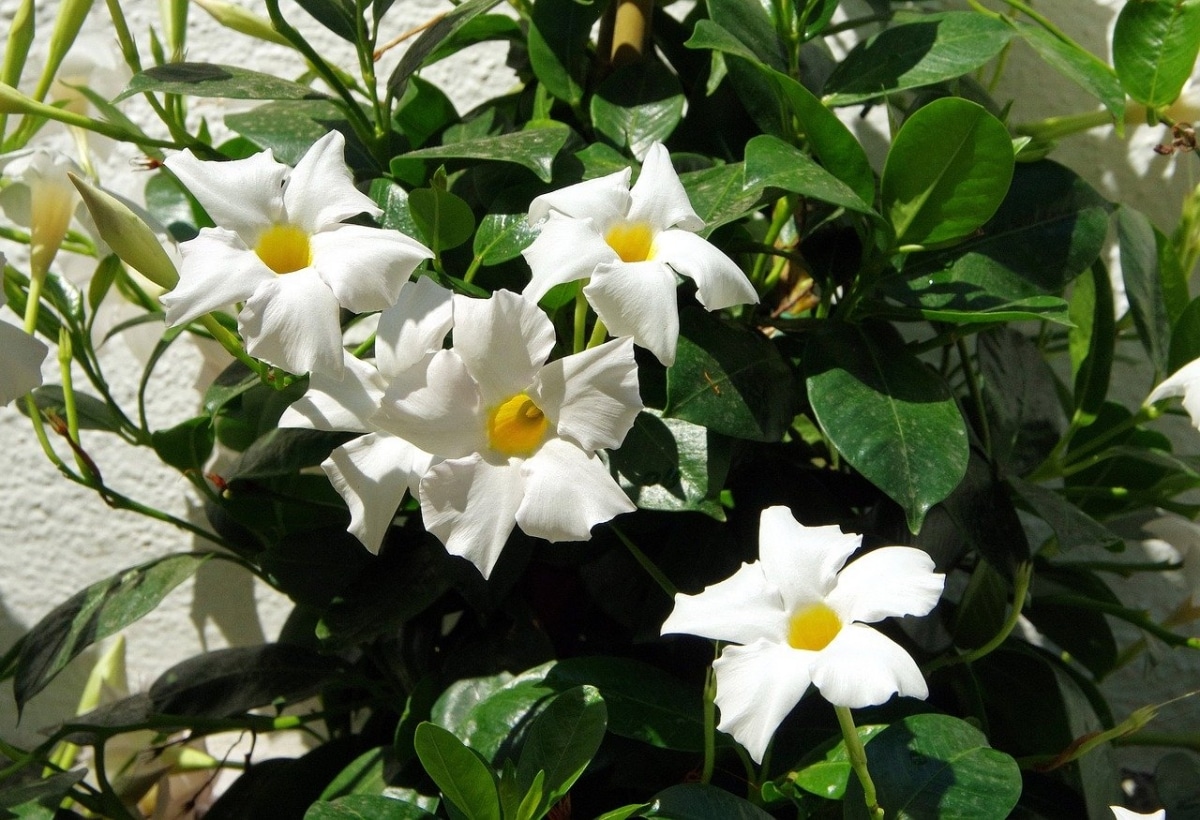
Image - Wikimedia / Jerzy Opioła
You could say that plant leaves are like human skin: when something bad happens, they are often the ones that show the first visible symptoms. Because, If our dipladenia is turning yellow, surely something is happening to it. It may not be anything serious, but it would not be strange if we were making a mistake when taking care of her.
Maybe it's the watering, the lack of light, or who knows? The same has run out of space and can not continue to grow. As there are several possible causes, let's see what to do if we have a dipladenia with yellow leaves.
Lack of water

Dehydration is a problem that can be very worrying, but it has an easy solution. When a dipladenia or another plant is thirsty, the first leaves that stop receiving the amount of water they need are the newest, because at this time it is more urgent that the roots remain well hydrated with the little water that is in the earth, because they are the ones that, when the situation improves, will help it to recover.
This can also mean that, when the time comes, the branches and leaves are "hanging", as if they had lost strength. Therefore, it is said that a plant that is thirsty looks sad. But as I say, it is easy to recover it. You just have to water it, pouring water until the soil is well soaked, completely.
If it is in a pot, we will take it and put it in a container that is a little higher than said container with plenty of water for half an hour. This will help the soil to soften, and can re-absorb the water.
Excess of water
When a dipladenia receives more water than it needs, its roots drown, literally. This is due to the fact that the air stops circulating between the pores or grains of the earth and between the roots, and this is a real problem, much more serious than dehydration, since if we do nothing, pathogenic fungi or oomycetes can appear in the soil like phytophthora and cause death.
In fact, the first symptoms appear on the roots, which either suffer minor damage or turn brown and eventually necrotic before the white mold (fungus) completely covers them. But of course, we will never know this, unless we take the plant out of the ground.
Now, other signs that will help us, at least to intuit, that we have watered the dipladenia in excess, is observe its old leaves, that is, the lower ones. These are the first to turn yellow. Why? Because they are the first to suffer when the root system is drowning.
What to do in these cases? The next:
- If the dipladenia is in a pot, we will take it out and wrap the ground bread with absorbent paper, double layer. If we see that this one gets wet quickly, we will remove it and put another one; like this until the one we put has a harder time absorbing moisture. Then, we will leave the plant indoors, in a room without drafts, and in a dry place for 12 hours. Only later will we plant it in a new pot that has holes in its base with new substrate, and we will apply systemic fungicide as this. We will resume irrigation after 2 or 3 days.
- If it's on the ground, we will suspend irrigation and apply polyvalent fungicide, such as No products found.. In the event that it has been planted in a very compact and heavy soil, it is best to remove it, make a larger hole and fill it with the brand's universal growing medium. Flower o weedness for example.

And to wait. It is important that it is watered from time to time, allowing the soil to dry out a bit before the next watering. To know when to water, it is possible to use a humidity meter as this, which is a very useful tool as a guide.
Lack of space
Dipladenia is a climber that has no invasive roots and develops thin stems. For all these reasons, you can fall into the mistake of thinking that you need little space; that is, it will be fine in a narrow pot or in a corner of the garden together with a few plants. Nothing could be further from the truth.
If it is kept in a pot, it is very, very important (and sorry for the repetition), that it be planted in a larger one every 3, 4 years at the most.. We have to observe from time to time if roots are sticking out or coming out of the drainage holes, and/or if the soil is worn.
On the other hand, if it is planted in the ground but we put it near large plants, the roots of the latter will prevent it from growing. For this reason, I do not recommend that you plant near a dipladenia plants such as: bamboo, banana trees, ensetes, or aggressive rooted trees or that need a lot of space to grow such as Ficus, ombú, horse chestnut, false banana maple, and the like.
Burns
Burns on the leaves occur when the plant is exposed to direct light, or when the plant is next to a window through which the sun's rays enter. The more direct it is, the more damage they cause. But we will know if the dipladenia is burning if we see that the leaves have spots that start out yellow but quickly turn brown.
These spots appear from one day to the next, and only on the most exposed leaves.; that is, it may be the case that it has spots only on a few leaves on a specific side, and that the rest look green.
What is done to recover it? If it is in a pot, take it to another place; and if it is on the ground, you will have to put a shading mesh on top or plant a plant nearby that provides shade, such as an evergreen shrub like the Photinia xfraseri 'Red Robin', whose red leaves will contrast with the green ones of the dipladenia.
He has reached the end of his life
Dipladenia is evergreen, but this does not mean that those leaves remain alive forever. Normally, the plant loses them little by little, throughout the year, as new ones appear. This is not a problem at all: it is something completely natural and we should not worry.
Another thing would be if many of them began to fall off at once, in that case we would have to see what happens to them: if they are yellow, we have already seen the possible causes; and if they fall green, it may have some pest that is weakening it, such as cochineal, aphids or red spider. These are treated with diatomaceous earth, of which we leave you a video here:
We hope that now you can find out what happens to your dipladenia with yellow leaves.